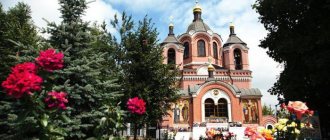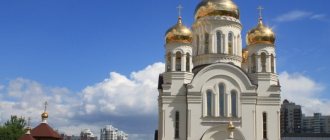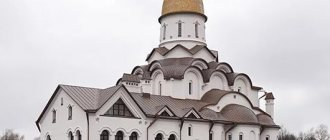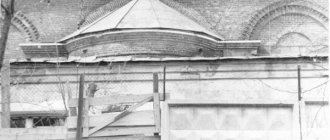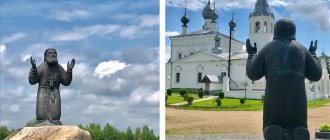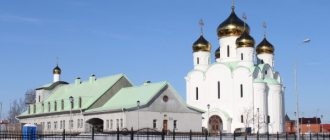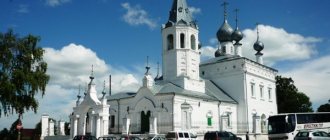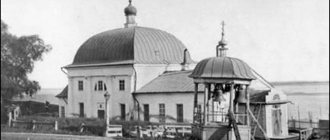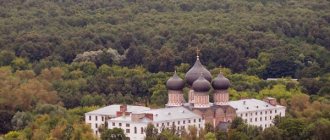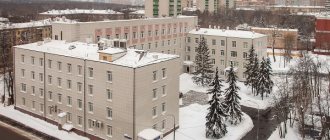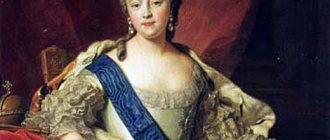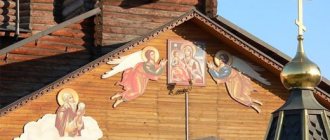"Save me, God!".
Thank you for visiting our website, before you start studying the information, please subscribe to our Orthodox community on Instagram, Lord, Save and Preserve † - https://www.instagram.com/spasi.gospodi/. The community has more than 60,000 subscribers. There are many of us like-minded people and we are growing quickly, we post prayers, sayings of saints, prayer requests, and timely post useful information about holidays and Orthodox events... Subscribe. Guardian Angel to you!
Today there are quite a large number of Orthodox churches. One of the most famous is the temple of Cosmas and Diamian in Shubin. It is located in Russia in the city of Moscow. Every year many tourists and pilgrims come to this temple. After all, this is one of the old temples that exists today.
Address of the Temple of Cosmas and Damian in Shubin
The Church of Cosmas and Damian in Shubin belongs to the Iversky deanery and is part of the diocese of the Christian faith of the city of Moscow. Location of the holy place: Shubino, Stoleshnikov lane, 2. There is a Sunday school and a teenage interest group here, and seminars are held for young people and older generations.
There are also support groups where you can get comprehensive help in the fight against drug and alcohol addiction.
Return to the fold of the Church and the current state
The restoration of the interior decoration of the Church of the Holy Unmercenaries Cosmas and Damian, which began in the late 70s of the 20th century, was completed in 1991. His Holiness Patriarch of Moscow and All Rus' Alexy II blessed the service in the renovated church, which was led by Father Alexander (Borisov).
Interesting! On July 14, the Orthodox world celebrates the day of remembrance of Saints Cosmas and Damian. On this day in 1991, a prayer service is held with the blessing of water and a religious procession with the participation of Dean Archpriest Vladimir Divakov, Priest Alexander and representatives of the clergy of neighboring churches.
The first solemn Liturgy was served on December 19, 1991 in honor of St. Nicholas the Pleasant in a small room, at which time the printing house continued its work in the church.
At the end of the autumn of 1992, the printing house moved to another location, the Northern aisle was consecrated anew and a gradual revival of church life began.
A team of restorers begins intensive restoration of the walls, clearing them of paint, and the ancient paintings have seen the light of day:
- Worship of the cross;
- Entrance to Jerusalem;
- Descent from the Cross.
Paintings depicting saints and metropolitans were restored, and the miraculous image of the Annunciation was discovered; Valentin Konovalov led a group of artists to create a new iconostasis.
Patriarch Alexy II of Moscow blessed the return to the Church of the icon of Saints Cosmas and Damian, which had been kept in the Church of the Resurrection of the Word since 1929.
In 1998, on Easter, the bells “sang” from the new belfry, and on November 14, 2000, the Divine Liturgy was performed in the Church of Cosmas and Damian, performed by Patriarch Alexy II.
Divine service in the capital's Church of Saints Cosmas and Damian in Shubin
During the service, Father Alexander was elevated to the rank of archpriest and the holy image containing the relics of the blessed Matronushka of Moscow was consecrated.
How to get there by car
Every year, from the first month of autumn to May, once a week, Catechesis is organized, during which everyone can devote themselves to the sacrament of Baptism. Procedure time: 18.30. If a person has already been baptized before, then you can become a church member by going through the procedure again.
Many try to get there by personal transport, but do not take into account the fact that the temple is located in an area closed to cars.
Only special-purpose vehicles have the right to enter from Tverskaya Street (you must turn after the 6th building, in front of the Moscow bookstore). You cannot park on the sidewalk, but there are private parking lots on the streets closest to this place, where you can leave your car and get to the temple on foot.
How to get there by public transport
The Temple of Cosmas and Damian in Shubin is a popular place among believers. Anyone can visit an Orthodox place using public transport: buses number 10 and 901 will take you to the Tverskaya Ploshchad stop , which is located near the temple.
This option is the most convenient in comparison with traveling by car, given the ban on parking vehicles and the impossibility of entering the church territory. The central location of the church building makes it possible to reach it by metro.
| Starting points | Direction |
| you need to follow the center along Bolshaya Dimitrovka or Tverskaya |
| It is recommended to go on foot in a similar way, along the above mentioned streets, only in the opposite direction. |
Shrines
The temple, founded back in the 14th century, has no preserved ancient values. The main shrines are holy images:
- the unmercenary Cosmas and Damian;
- icon of the blessed Matrona.
Temple icon of Saints Cosmas and Damian in the Shubinskaya Church
You can always meet people around them praying about their problems.
History of the temple
According to legend, in Rus' “fur coats” was the name given to the territory where furriers lived who were engaged in the trade of furs and fur coats. According to another historical explanation: on this land in the 14th century lived the boyar Iakinf Shuba, who put his signature on a document prepared by Emperor Dmitry Donskoy.
Since the 18th century, the street, stretching from Tverskaya Square to Bolshaya Dmitrovka, was called “Shubnaya”, and later became “Kosmodamianovskaya”, in the name of a nearby place for believers. The temple in Shubin was noted on the pages of the Sophia Vremennik in the 14th century.
The publication mentioned that Iakinthos Shuba decided to build a place where believers could pray; initially it was named after him, and later in honor of Cosmas and Damian. Documents from 1625 from the spiritual archive confirm the presence of a temple made of wood from the chapel of St. Nicholas the Wonderworker.
In 1626 there was a fire that completely destroyed the building.
On the territory where the church previously existed, they began to build a new structure dedicated to the Annunciation of the Blessed Virgin Mary. The throne of Damian and Cosmas was previously located in the dining room, but after 58 of the 19th century it was moved to the central room.
It is impossible to accurately indicate the year and month of completion of construction work, where stone became the main material , but the masonry shows that it was no earlier than the mid-17th century. This is evidenced by the found brick of the eagle type. In the book of Opisnaya, which contains information about the churches of the White City, there is an entry where a stone temple is described, “measuring 19 fathoms in length and the same amount across.”
A major overhaul of the structure was required already in the first decade of the 18th century, but work was suspended 11 years later: an order was issued that prohibited stone construction work in the capital of Rus'. Only in 1722 were repairs continued after the relevant decree was issued to complete the restoration.
In 1773, the building was again engulfed in fire, the destructive consequences of which were eliminated only in 1785.
In 1812, those who were accused of “setting fire to Moscow” were shot near the church, but the building itself was not touched by the fire. The southern limit of Saints Damian and Cosmas and the new bell tower of the northwestern part of the building were erected in the late 50s of the 19th century.
At the beginning of the last century, many icons, due to circumstances, were taken from the storage facility, and at the end of the 20s of the 20th century the building was closed to believers. During a difficult period, the building served as a library archive of foreign foreign language books; a little later, the book printing office of the Ministry of Culture of the Soviet Union was located here.
The beginning of the 30s was marked by the destruction of the belfry to the second level, as well as the construction of an extension in the form of a residential building with the Aragvi tavern. By the early 60s, there was a proposal to finally demolish the building and put an apartment building in its place.
Historically, this idea was not realized; in the late 70s, restoration work was carried out, and the appearance of the church building was transformed. An arts and crafts specialist made a glass mosaic of the patron saints.
Restoration is carried out in the holy place to this day.
A little history
According to historical facts, the first temple in honor of Cosmas and Diamian was built in 1368. It was founded by Dmitry Donskoy. The existing building was built in 1722. But since that time it has been restored and rebuilt more than once.
At one time the temple was very popular among the noble population. Even Prince Gagarin, the Tyutchevs, the Dokhturovs and many other representatives of the elite were his parishioners. The funeral service for the great artist V. Surikov was held in this church. But for unknown reasons, the temple was closed in 1929 and a library of foreign literature was placed on its premises. But in the late 70s, restoration work began to be carried out in the building to restore the temple itself, and in 1991 it began to be restored and began to receive parishioners again.
The best article for you, go to: Cathedrals and temples of St. Petersburg
It should also be noted that the church has a psychological service and a prayer singing group. This service hosts Alcoholics Anonymous meetings. In the temple there is an icon of Cosmas and Dimian to which parishioners come to pray and ask for help in different life situations.
Architect and exterior decoration of the temple
The present appearance of the building has existed since 1722; since that time, numerous restoration works have been organized in the temple. In the 20s of the 19th century, Alexander Elkinsky (architect of the Capital Buildings Commission) organized a charitable fundraiser in the name of the Resurrection of the Word, thanks to which the belfry and apses were erected.
The church furnishings and interior were improved a little later - in the 40s, thanks to the merchant V.I. Borisovsky, an iconostasis consisting of 3 tiers with columns was installed at the same time. In 1979, Cherevataya O.V. completed the delicate work of reconstructing the appearance of the central structure.
At the same time, A. Karnaukhov made a unique composition depicting the faces of saints.
Architectural ensemble of the temple
The Temple of Cosmas and Damian in Shubin was built using elements of the Baroque style. Its distinctive features are miniature decoration, simplicity and lack of pathos, which creates the right atmosphere for immersion in prayer. The corners of the building are distinguished by peculiar blades, the edges of the octagon are distinguished by rectangular niches.
The Temple of Cosmas and Damian in Shubin was built using elements of the Baroque style
The windows are decorated with plates with damaged ends on the front of the wall.
In modern times, the external texture of the temple was modified to the desired result, and the bell tower was reinstalled. A new life for the external decoration of the holy place began in 1992, after the registration of the community of the Orthodox faith. In 93 of the last century, the building was transferred to the use of the church, and the first liturgy was served a year later.
The ceilings of the second level were dismantled 2 years later, after which the belfry was erected another 3 years later, and soon, by Easter, new bells were installed. By 2005, the temple was completely painted by artists . The restorers invested a lot of time and effort into restoring the unique painting in the central part of the prayer house.
In the process, the icon of the Annunciation of the Blessed Virgin Mary was revealed under the paint.
Social Ministries
The Church of the unmercenary saints Cosmas and Damian has become truly national, its doors are open to everyone who wants to join the Orthodox faith.
The following people work at the temple:
- Holy Scripture reading groups;
- youth communication club;
- a charity club that collects and distributes clothes for all those in need;
- Sunday School;
- teen club.
Parishioners come in families for pastoral conversations. Before adults receive Baptism, they are taught the basics of Catechesis. The ministry at the Children's Clinical Hospital was started by Father Men and continued by Father Chistyakov and a group of church youth.
Since 2007, new refectory buildings and other buildings for social services have been erected.
On a note! Church service is carried out by psychologists and people from the working community “Noah”, helping those who have nowhere to live, or those who have lost themselves in this world, those who are addicted and condemned.
Shrines and relics of the temple
In 1997, the icon of the Unmercenaries of Assia was brought here, which for a long time had been in the Cathedral of the Resurrection, located in Bryusov Lane. Another important relic that believers try to touch is the icon of St. Matrona of Moscow. There is also a piece of her relics.
Among the things dear to the temple, there are forged iron doors from the 18th century, which are reminiscent of a difficult period in the history of the church, as well as a white stone tombstone made in the form of a Baroque cartouche (it was used as a support for the church hill).
Church of Cosmas and Damian in Shubino
Stoleshnikov Lane got its name because in the 16th and 17th centuries, stoleshniks lived here - weavers who produced tablecloths for the royal court. P.V. Sytin o. V.A. lived in Stoleshnikov Lane. Gilyarovsky, who said that in him, “like the sun in a drop of water, the whole life of the city is reflected.” At V.V. Mayakovsky has wonderful lines:
I love Kuznetsky (forgive the sinner!), then Petrovka, then Stoleshnikov; I follow them a hundred or two hundred times a year from Izvestia to Izvestia.
According to one version, the name of the Shubino area was given by “furriers” - furriers who traded in fur coats and furs. I.K. Kondratyev writes about this in “The Hoary Antiquity of Moscow.” According to another, more substantiated version, here in the 14th century was the courtyard of the boyar Iakinf Shuba, an associate of Dmitry Donskoy. In 1368, the Lithuanian prince Olgerd went to war against the Moscow principality. N.M. mentions this. Karamzin in the “History of the Russian State”: “The amazed Grand Duke sent messengers to gather the army and, wanting to stop the enemy’s desire, ordered the boyar, Dimitri Minin, to go forward with only the Moscow, Kolomna and Dmitrov regiments.
The second chief was the governor of Prince Vladimir Andreevich, named Iakinf Shuba. Already Olgerd, like a lion, raged in the Russian possessions: not inferior to the Mongols in cruelty, he captured unarmed prisoners and burned cities. Many of our princes and boyars died on the spot, and the Moscow regiments were completely exterminated. For three days Olgerd stood under the walls of the Kremlin, plundering churches and monasteries, without approaching the city.” Iakinf Shuba died heroically in a major battle near Lake Trostenskoye. Famous historian I.M. Snegirev associated the name of the Shubino area with the messenger Shubin-Gryaznov, who may have been a descendant of Iakinf Shuba.
Saints Cosmas and Damian were brothers who lived in Asia in the 3rd century. The Romans called Asia (or Asia) the southwestern part of the present peninsula of Asia Minor. Over time, the name Asia began to be applied to the entire peninsula and, finally, to the entire part of the world lying to the east of Europe. The life of Cosmas and Damian, written by Demetrius of Rostov, says: “Cosmas and Damian were like two lamps on earth, shining with good deeds. They received from God the gift of healing and gave health to souls and bodies, healing all kinds of illnesses, healing every ailment and every ulcer among people and casting out evil spirits.”
Even after their death, Saints Cosmas and Damian continued to perform miracles. The brothers were buried in the same tomb, to which a huge number of sick people came and received healing. Already in the 4th–5th centuries they began to be revered as the patrons of doctors and pharmacists, and later of all beggars. People turned to Cosma and Damian for help during epidemics and treatment of ulcers and other diseases. In Rus', the holy brother doctors were the patrons of the holiness and indissolubility of a true Christian marriage, the organizers of a happy marriage. People considered them “handicraftsmen,” unmercenary blacksmiths, or God’s blacksmiths.
On the day of remembrance of the saints, the blacksmiths had a professional holiday on which they never worked. The iconography of the saints reflected their involvement in medicine: they were depicted holding boxes for storing medicines in their hands. E.L. Madlevskaya in the encyclopedia “Russian Mythology” notes: “To whom Demyan was revered as the patron saint of doctors and healers and they turned to them with requests and prayers for the healing of people or animals. The names of saints are often found in spell texts aimed at getting rid of bleeding, hernia, tremors (fever) and other ailments.
This is, for example, what the appeal looks like in the Tobolsk conspiracy for toothache, where the holy brothers turn into a single character: “Father Kozma Demyan lies in a cave, his white teeth do not hurt, and my servant of God (name) does not have pain.” In Rus', unmercenary brothers were treated with special trepidation, love and reverence. They were perceived as blacksmiths who forged wedding crowns and weddings themselves, and the well-being of the marriage depended on the quality of the work of the holy blacksmiths. Before the wedding, the bride addressed Cosmas and Damian in a wedding song:
Mother, Kuzma-Demyan! Forge us a wedding tightly, until the gray head, until the long beard! Kuzma-Demyan walked through the hallway, collected nails, forged a wedding!
The first mention of a church in the Shubino area is found in the Sofia vremennik under 1368. It says that the governor of Dmitry Donskoy “Iakinthos Shuba had a courtyard near Tverskaya, founded a church named after Iakinthos, and then the second Cosmodamian chapel appeared in it.” The oldest name of the church was “Cosmas and Damian on Rzhishchi”. Once upon a time, there were wide rye fields in this place, near which folk festivities took place. In documents of the 18th century, another name is found - “Cosmas and Damian, behind Gagarin’s yard”, because on Tverskaya Street since the 17th century there was an estate of the noble princes Gagarins.
In archival documents, the Cosmodomian Church was first mentioned in 1625. Then the temple was wooden and had chapels of St. Nicholas and the Hieromartyr Polycarp. In 1626 there was a severe fire in Moscow. Instead of the wooden church that burned down during the fire, they decided to build a stone one. Apparently, the construction of the temple was delayed, since the eagle brick discovered by restorers in the masonry of the building usually dates back to the mid-17th century. The main altar of the newly built church was consecrated in the name of the Annunciation of the Blessed Virgin Mary. However, the people still called the church Cosmodamian.
In 1703, a major reconstruction of the severely dilapidated temple began. The parish of the Church of Cosmas and Damian in Shubin was poor, so restoration work dragged on for ten years. And the decree of 1714 banning stone construction in all of Russia, except St. Petersburg, interrupted construction for an indefinite period. Only eight years later, the restoration of the temple continued: “On the 6th day of October 1722, the decree on the construction of the church was sealed according to the petition of the Church of Cosmas and Damian in Shubin, priest Dmitry Ivanov and his parishioners ordered them to complete the unfinished stone Kosmodemyansk Church against the decree.”
How the priest managed to obtain permission to resume construction of the temple “against the decree” remains a mystery to researchers. The Church of Cosmas and Damian acquired the appearance characteristic of the first quarter of the 18th century, but retained the planned composition and parts of the masonry of the temple, founded in 1626. A wide octagon was erected above the quadrangle, completed by a vault with a dome on an openwork white stone stand made of volutes. As a result of construction that dragged on for more than twenty years, the Kosmodemyanskaya Church absorbed the architectural features of the late 17th - early 18th centuries.
Figured platbands on the quadrangle windows and arched volutes attached to the neck of the dome - such a combination can only be found on parts of the same temple at different times. At the same time, a two-tier bell tower was built (also an octagon on a quadrangle), completed with an elegant spire. In the 18th century, a frequent toponymic clarification in the name of the Cosmodamian Church was “behind the Golden Lattice.” Researchers don't know exactly where this grating was located. Perhaps it covered the beautiful high porch that led to the temple of Cosmas and Damian in Shubin from the alley. In 1773, the church was repaired after another fire.
During the French invasion of Moscow in 1812, a real miracle happened: the temple of Cosmas and Damian in Shubin survived the terrible Moscow fire and was not even plundered by the enemy, although all the neighboring buildings were badly damaged. In September 1812, the “lighters of Moscow” - Muscovites who were accidentally captured on the streets - were shot near the walls of the church. According to contemporaries, “the innocent victims suffered death” in front of the icon of the Savior depicted outside on the church wall. According to the church certificate of 1813, “the church of Cosmas and Damian is in good condition, did not burn, and was not damaged in any way, either externally or internally.”
The same certificate states: “Silver items such as: three Gospels, two vessels, three crosses, two censers and frames of images, how many of them there were, were kept, robes of silk fabrics in pairs of ten and books needed for the priesthood are available, parish Three courtyards remained unburned, two of the burned ones are being rebuilt, the priests and clergy do not have their own houses, but they live in the allotted government house of the commander-in-chief.” During the post-fire reconstruction of Moscow, the Church of the Resurrection of the Word on Dmitrovka was closed and dismantled. Her parish was transferred to the Kosmodamian Church, to which the northern Resurrection chapel was added.
The octagon of the bell tower was surrounded by columns of the Tuscan order. Next to the church, along the line of the alley, a two-story stone Empire clergy house was built. The “Moscow Church Gazette” for 1889 provides interesting details: “In 1840-42, this temple was renovated through the diligence of the church warden, an honorary citizen of the first guild of merchant V.I. Borisovsky. In the present Church of the Annunciation there is a three-tiered iconostasis with columns and carvings of the best work, gilded with newly painted icons. The temple was consecrated by His Eminence Metropolitan Philaret in 1842, in the spring, and the word was spoken.”
In 1857, through the efforts of the sons of the merchant Borisovsky, a new one was erected instead of the previous bell tower. At the same time, the southern aisle was built, where the Cosmodamian throne was moved from the refectory. The Empire style treatment of the facades was replaced by a pseudo-Byzantine one. In 1887–1897, at the expense of the merchant D.R. Vostryakov, who donated more than 10 thousand rubles to the church, painted the dome, walls of the temple and altar with oil painting, updated the main iconostasis and built a new iconostasis in the chapel of Cosmas and Damian. In the 1910s, the regent of the temple was the composer P.G. Chesnokov, whose works were included in the repertoire of the Synodal Choir and other large choirs.
In 1922, after the decree of the All-Russian Central Executive Committee on the confiscation of church valuables to help the starving, the Cosmodamian Church was looted. More than seven pounds of silver, one diamond, forty precious stones, a chasuble with precious stones and a cross with a diamond were seized. In 1929, the temple of Cosmas and Damian was closed. Four years later, the church's bell tower was destroyed down to the second tier. A residential building with a restaurant “Aragvi” was built nearby. At the end of the 1950s, they wanted to build a multi-storey building instead of the Cosmodamian Church. Fortunately, this project was not implemented. For a long time, the building of the temple housed the book depository of the Library of Foreign Literature.
In 1958, the church housed the printing house of the economic administration of the Ministry of Culture. The chief engineer of the printing house, V.A. Svetlov, ordered that the frescoes be covered with paint, but in such a way that they could be easily restored. Although the Cosmodamian Church was saved from demolition, some destruction could not be avoided. The temple premises were adapted for the needs of a printing house, and an extension was made to the building. A dog walking area was set up near the altars. In the 1970s, the two-story clergyman's house from the 19th century was demolished. In 1977, restoration began: the dome with a gold openwork cross, the top row of quadrangle windows and some decorations of the octagon were restored.
In the summer of 1991, with the blessing of Patriarch Alexy II, services resumed in the Kosmodamian Church. True, they took place in a small room in the lower tier of the bell tower, because the church building continued to be occupied by a printing house. On Easter 1992, after a sixty-year break, the Divine Liturgy was celebrated again in the Church of Cosmas and Damian. Only in 1995 were the structures of the second floor of the printing house dismantled and work began on restoring the interior of the temple. Thanks to the restorers led by V.G. The Vetoshnovs managed to uncover and restore the 19th century paintings in the central part of the temple.
The restorers had to do a colossal job: sometimes they had to remove up to ten layers of paint in one place. During restoration work, an icon of the Annunciation of the Blessed Virgin Mary was found under a layer of plaster in the central altar. On November 13, 1997, the temple icon of the unmercenary saints Cosmas and Damian of Assia, which had been kept for a long time in the Church of the Resurrection of the Word in Bryusov Lane, was returned to the Cosmodamian Church. In 1998, a belfry was finally erected near the Cosmodamian Temple. New bells were cast at the ZIL plant and installed just before Easter.
Almost invisible from the crowded Tverskaya Street, the Church of Cosmas and Damian in Shubin is undoubtedly worthy of the attention of everyone who walks in the Tverskaya Square area. A simple eight on a quadruple has a number of characteristic features. The corners of the temple volumes are highlighted with blades, the edges of the octagon are decorated with wide rectangular arched niches. The quadrangle windows are framed with platbands with torn pediments in the spirit of the Moscow Baroque. In the northern portal of the church, forged iron doors have been preserved, which, according to researchers, date back to the first quarter of the 18th century - the time of construction of the temple.
To the east of the southern portal, a white stone gravestone in the form of a Baroque cartouche has survived in the outer wall. The lower white stone part of the fence, which appeared in the 18th century, served as the retaining wall of the church hill. The different-time elements of the Cosmodamian Church are surprisingly harmoniously combined with each other. In 2105, this distinctive Moscow church finally had a real bell tower again, and it regained its voice. Today, at the Church of Cosmas and Damian in Shubin there is a parish Sunday school, an Orthodox youth seminar and a Bible society seminar.
Mentors
Peter Ilyin, who is known as Bishop Ilarius, served here from the 14th year of the 20th century until the next suspension of the prayer house’s activities. At that time, Ilya Komov was the headman. The reading of prayers continued in 1991, Alexander Borisov was chosen as rector, and later in 2000 he was elevated to the rank of archpriest.
The next 4 years of services and liturgy were conducted by Vladimir Lapshin. Today he is the rector of the Cathedral of the Assumption of the Blessed Virgin Mary. At the same time, since 1993, the liturgy was conducted by Georgy Chistyakov. He died in 2007. Everyone who was rector in the church graduated from the Theological Seminary in Moscow or Smolensk.
| Abbots and ministers | San | Years of service | Helpful information |
| Petr Ilyin | father | From 1914 until the closure of the temple in 1929 | He had the rank of Archbishop of Chuvashia and Cheboksary. |
| Alexander Borisov | archpriest | Since 1991 | Graduated from the Lenin Pedagogical Institute, Candidate of Biological Sciences, Candidate of Theology |
| Georgy Chistyakov | priest | Since 1992 | For some time he conducted services in the prayer house of the Intercession of the Blessed Virgin Mary at the department of the children's hospital. Candidate of Historical Sciences, graduated from Moscow State University. |
| Alexander Kuzin | archpriest | From 02/15/2000 | Graduated from the Moscow Aviation Institute. |
| Ioann Vlasov | archpriest | — | Graduated from Theological Seminary. |
| Petr Kolomeytsev | priest | From 1.02.2012 | Received a diploma from the Moscow Architectural Institute. |
| John | hieromonk | Since 2014 | A native of Italy, he graduated from a university in Geneva, an Italian university of linguistics, the International Institute in Florence, a church-wide graduate school and doctoral studies named after Cyril and Mythodius. |
| Sergiy Bulychev | deacon | — | Theological Seminary |
| Alexander Konstantinov | deacon | — | Theological Seminary of Smolensk |
Service schedule, operating hours
Every day the church holds evening (“vespers”, “pastoral conversation” at 6 pm) and morning (“matins” at 8:30) services. The exception is the first two days of the week. On Sunday morning you can attend two Liturgies (7 and 10 am), and on Saturday evening you can attend the All-Night Vigil.
Also on the same day at 11 noon, Water Blessing prayers are held. The rector is waiting for everyone to go to confession on Friday at 18.00. Funeral services are held daily after the service. Those who want to participate in the Akathist to Damian and Cosmas must plan their trip on Sunday in order to arrive by 6 pm.
Schedule of the Temple of Cosmas and Dimian in Shubin
The church holds daily morning, liturgical and evening services except Monday and Tuesday. On Saturday evening the All-Night Vigil is celebrated here, and on Sunday morning two Liturgies take place at once.
Confession is held on Friday evening at 18:00. Panakhidas are served daily after each service. But the Akathist to Cosma and Damian is read only on Sundays in the evening from 18:00-18:30 pm.
The Lord is always with you!
Rules for visiting the temple
The church opens its doors to believers, regardless of summer or winter time, from 8 or 10 am to 8 pm. Nearby, a book kiosk offers a wide selection of relevant specialized literature, where you can purchase all the necessary paraphernalia. At the temple you can attend classes in preparation for churching and baptism.
The Temple of Cosmas and Damian in Shubin is a holy place, a visit to which requires adherence to unspoken rules that cannot be broken.
General norms of behavior include a ban on drinking alcohol, smoking, and loud talking. The altar is placed on a small platform called a solea. It is unacceptable to step on the pulpit, and its so-called central part, and on the salt itself without the permission of the priest.
You can learn what to wear and how to behave in church from this video:
Before entering God's territory, the believer must cross himself and bow, then, after going through the door, do it again, crossing 3 fingers of his right hand together, successively touching them to the forehead, stomach, right and left shoulder.
It is recommended to be punctual when visiting church: arrive at a pre-scheduled service in order to have time to buy candles and also leave donations. If you manage to get to the service during it, you should not make noise and disturb others’ prayers, but quietly join the prayer service.
Prayer is said only while standing; parishioners who are sick or very tired are allowed to sit. If you decide to visit the temple with a child, you must ensure that he does not scream or run; if he cries, the mother should take him outside so as not to disturb others.
Phones should be turned off or put on silent mode.
Appropriate clothing is an important component of visiting the temple. It is recommended to cover most of the body, excluding sports items, short skirts and shorts, and shirts with short sleeves. Women need to cover their heads and also refuse cosmetics.
When meeting mentors, you should say: “Father, bless!” During the blessing, after crossing the palms, they kiss the priest’s right hand.
HISTORICAL REFERENCE
| The parish of the Church of the Unmercenary Saints Cosmas and Damian in Shubin has been known since 1625. The modern building of the three-altar church was built in 1857. Architect unknown. Altars: the main one is the Annunciation of the Most Holy Theotokos, the chapels are the Resurrection of the Word and the unmercenary saints Cosmas and Damian. The consecration of the thrones was performed only by the priestly rite in 1991, 1992 and 1995. During the years of persecution, the parish was deregistered, and the church was closed for worship and transferred to the national economy in 1929. In 1991, the parish was revived and received legal registration. In the same year, the former church building was transferred to the parish. His Holiness Patriarch of Moscow and All Rus' Alexy II performed Divine Liturgies in the church on the days of patronal holidays on November 14, 2001 and 2006. |
SACRED TEMPLE
Temple icon of the unmercenary saints Cosmas and Damian, icon of the blessed Matrona of Moscow with relics.
WORSHIP
On Wednesdays, Thursdays, Fridays and Saturdays - Matins and Liturgy at 8.30 am, on Sundays - two Liturgies at 7 and 10 am. (from Trinity to the Transfiguration one Liturgy is served on Sundays at 10 a.m.), the day before - all-night vigil at 6 p.m., on Sunday at 6 p.m. — Vespers with akathist and pastoral conversation.
Divine service (summer schedule): The temple is open daily from 8 (10) to 20 o'clock, there is a book kiosk. The church hosts classes in preparation for baptism and churching.
Divine service (winter schedule): The temple is open daily from 8 (10) to 20 o'clock, there is a book kiosk. The church hosts classes in preparation for baptism and churching.
Divine service (Lent): On Wednesdays and Fridays, as well as on days provided for by the Orthodox calendar - Liturgy of the Presanctified Gifts at 8-30. Unction is celebrated on Monday or Tuesday of the 3rd, 4th and 6th weeks. During Holy Week, daily services are held. On Easter three Divine Liturgies are celebrated: at 0 o'clock, at 7 o'clock and at 10 o'clock
CLERGY
| Archpriest Alexander Ilyich BORISOV, rector. Born October 13, 1939. Education: Moscow State Pedagogical Institute (MGPI named after Lenin), Moscow Theological Academy, candidate of theology. In 1991 he was appointed rector of the temple. |
| Archpriest Alexander Iosifovich KUZIN. Born August 29, 1946. Education: Moscow Aviation Technology Institute, Moscow Theological Seminary. |
| Archpriest John (Ivan) Viktorovich VLASOV. Born June 26, 1966. Education: Moscow Theological Seminary. |
| Hieromonk JOHN (Guaita), full-time clergyman of the church parish. Born November 26, 1962. Education: University of Geneva, Theological Institute of Florence. On March 28, 2010, he was ordained to the rank of deacon. On September 11, 2010, he was ordained to the rank of presbyter. On October 31, 2010, he was tonsured a monk. |
| Priest Peter Leonidovich KOLOMEITSEV. Born June 18, 1959. Education: Moscow Architectural Institute, Moscow Theological Seminary. |
| Deacon Sergiy Mikhailovich BULYCHEV. Born May 14, 1959. Education: All-Union Correspondence Institute of Textile and Light Industry, Smolensk Theological Seminary. |
| Deacon Alexander Viktorovich KONSTANTINOV. Born May 12, 1977. Education: Moscow State Agroengineering University named after. V.P. Goryachkina, Smolensk Theological Seminary. |
DRIVING DIRECTIONS
The church operates a parish Sunday school, a teenage club, an Orthodox youth seminar, an Orthodox seminar for adults, and psychological support groups. Help is provided to persons suffering from alcoholism and drug addiction. Every year from the end of September to the end of May on Thursdays at 18-30 Catechesis is held, i.e. classes for everyone who wants to receive the sacrament of Holy Baptism, as well as for those who have previously received Holy Baptism and want to join the Church
How to get there by public transport: metro stations "Okhotny Ryad", "Teatralnaya", "Tverskaya", "Pushkinskaya", "Chekhovskaya". Then walk to Tverskaya Square.
How to get there by car: the temple is located in a pedestrian zone. Special vehicles can enter from Tverskaya Street, turn past No. 6 (in front of the Moscow bookstore). Car parking in the pedestrian zone is not provided and is only possible in paid parking lots on nearby streets.
Patronal holidays
It is customary to hold parish meetings in the church in honor of upcoming Orthodox holidays. In January - in honor of the Nativity of Christ, in March - in honor of Great Lent, and in May a spring retreat is planned. Catechesis classes (gaining knowledge about the fundamentals of the Christian faith) are held from October at 18.30 on Thursdays, in the format of lecture meetings and group classes.
Everyone who wants to receive the Sacrament of Baptism in the future is invited to such events, as well as those who have already been baptized, but have not been imbued with faith in their souls. The course of lectures helps you understand your spiritual purpose and the predestination of a Christian person. Training material is provided by Archpriest Alexander, and group classes are led by parishioners.
Such meetings are held absolutely free.
Interesting facts about the temple
It is noteworthy that the parishioners of the temple included famous representatives:
- the princely family of the Urusovs of Nogai origin;
- Bolkhov principality of Solntsevo-Zasekina;
- descended from the princes of Chernigov - the Odoevsky family;
- branches of Rurik and the Golibesovsky princes - Gagarins.
Representatives of the noble family were frequent guests:
- The Tyutchevs are descendants from the Uglich-Myshkinsky Upper Volga region;
- The Dokhturovs are descendants of the hero of the Battle of Borodino;
- Chertkovs from Yaroslavl and Vladimir provinces;
- The Kozhins are the generation of the “honest husband” Yuri Bakhta-Franz, who came from the kingdom of Sweden;
- belonging to different classes, Meshcheryakovs.
At the beginning of the last century, composer Pavel Chesnokov played his music here. In the 16th century, a memorial service was held for the famous artist Vasily Surikov.
Information for pilgrims
The parish does not organize pilgrimage trips, but periodically publishes announcements about planned trips on its website.
For example:
- to Germany;
- Israel;
- Portugal;
- Altai;
- Georgia;
- Morocco;
- Great Britain;
- Italy.
Each pilgrimage trip includes an exciting program of visiting holy places, historical and cultural heritage, and architectural monuments. The temple, built and named in honor of Saints Cosmas and Damian, tries to help everyone who needs psychological and spiritual support.
To pray, be baptized, or touch a holy place in person, you need to go to Shubino, which is located in the center of Moscow. also learn about the history and life of the church online on the social networks Intagram and Facebook, where church representatives publish a schedule of upcoming parish meetings.
Article design: E. Chaikina
Psychologist Peter Dmitrievsky
Teenage camp of the Church of St. Cosmas and Damian in Shubin (Moscow)
I am the director of this camp.
Together with a team of like-minded people, we have been running the camp for 16 years. Below is a description of the goals and objectives of the project. 1) We pay attention to physical and psychological safety.
Children are supervised most of the time. On the one hand, this is because the program is quite rich. On the other hand, in their free time, one of the counselors also checks to see if everything is in order. Someone communicates with the guys, someone plays with them. After the rain, the presenters check to see if everyone has changed clothes. If it gets cold, we check to see if everyone is adequately dressed.
A team that includes many psychologists and teachers takes care of psychological safety. The program was designed taking into account the age of the participants. For example, from evening events, younger children (11-12 year olds) go to bed earlier. We do not “load” serious information for a long time and do not drag out the “riot”.
2) And here are our ideas about usefulness. The parent has the right to know them in advance.
Psychological safety implies that children will not be instilled with ideas and values that will interfere with their life. Here it is important for us to coordinate our positions with our parents - after all, what seems useful to one adult may be considered harmful by another. That's why we describe here the worldview behind the program.
We imagine that the teenager: (a) strives to live an interesting, happy life (in Christian terminology: “rejoice”
) and (b) needs skills to cope with pain and crises (in Christian terminology:
“finding comfort in sorrows”
).
We believe that the key to joy and comfort is the development of three skills in a teenager: 1) The skill of awareness of oneself, one's experiences, needs and motives (which correlates with the concepts of “wakefulness”
and
“self-observation”
in the Bible).
2) The skill of building sincere and mutually enriching relationships with people ( “love”
in Christian terminology).
3) The skill of interacting with Jesus Christ in prayer, in contact with the Word and in the sacraments, the skill of “walking before God
.
This worldview is conveyed during a program that includes: - self-disclosure of the presenters, - exercises and games in small groups with a constant composition, - joint discussion of Gospel texts, prayer meetings, answers from the priest to anonymous questions, - bright, memorable entertainment events that give teenagers experience of obtaining joyful emotions without the involvement of alcohol and drugs, - organizing platforms for teenagers to be active and try themselves, - organizing discussion platforms on topics that are relevant for a given age, - sports, creative clubs, swimming, cinema, dancing.
3) The camp has an interesting, varied program.
We wrote a little about this above when we described the program.
The program alternates fun events with calm, “meditative” ones. Sports events and creative clubs are held every day. In good weather we go swimming. Sometimes we watch a good movie. Traditionally, the camp hosts a big game like “Zarnitsy” and a carnival, where we reproduce some era or atmosphere of some book. Religious activities
are offered to adolescents taking into account their specific perceptions. At morning prayer, in addition to the canonical prayers, we sing Christian songs with a guitar. Often these are Psalms arranged by musicians to modern calm melodies. The songbook also includes songs from different groups (Aquarium, Mashina Vremeni, DDT), in which, not directly in religious words, they sing about the eternal and serious. Discussing a passage from the Gospel means that the presenters will ask teenagers questions related to the Gospel text: which words are unclear, what they agree with and what they don’t, what God might want to tell people through these words, whether they have been in similar situations. In other words, teenagers have the opportunity to respond to the sacred text. Teenagers will speak at will. The task of such groups is to get to know each other better through conversation about Scripture, to respond spiritually to the sacred text and together figure out what Jesus of Nazareth wanted to tell people. The reflections of teenagers (including those from non-church families) are often extremely enriching for the adults participating in the discussion. A meeting will be organized at the camp with a priest who will respond to anonymous notes. Those priests who come to us treat the children with sympathy and respect, answer informally and also take into account the age and context of the teenagers. Overall, our goal is to offer teens Christian practices and ways of looking at events in life that will help them live full, joyful lives and find comfort in difficulties.
Our experience shows that the camp program is received with interest by both church-going children and ordinary “universal” teenagers who are not specifically interested in religion.
Parish Camp Page.
